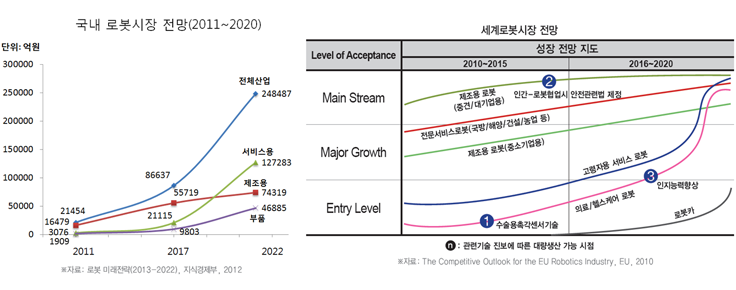Post-graduation - 로봇공학과
The Future of the Robotics Industry

Source: Trends in the Domestic and International Robotics Industry, Korea Institute of Robotics & Technology Convergence (KIRO)
The government announced the Robot Future Strategy (2013-2022) on October 17, 2012, which details the framework of robot policy for the upcoming decade. This plan signifies progress from previous strategies aimed at supporting the robotics industry, suggesting its promotion to a national key industry. The Ministry of Knowledge Economy has forecasted that there will be a rise in the demand for robots in the future, driven by heightened competition in manufacturing productivity, increasing welfare needs, safety considerations, the expansion of human activity into extreme environments, and societal shifts including low birth rates and an aging population. The future prospects of the robotics industry are optimistic not only within the country but also internationally.
Robot Utilization Industry
The robotics industry, being a technology-intensive field that integrates machinery, electrical/electronics, and computer systems into a single cohesive system, has a significant national impact and is regarded as a next-generation industry. Due to the interdisciplinary nature of this field, career opportunities extend beyond robotics to related industries. Graduates can also pursue advanced studies in graduate school and engage in specialized research, opening doors to various professional pathways.
| Representative Field | Subfield | Photo Example |
|---|---|---|
| Manufacturing Robots |
Electronics/Electrical |
 |
| Professional Service Robots |
Defense Robots |
 |
| Personal Service Robot |
Home robots Entertainment robots Security robots Transport robots Assistive robots Healthcare robots |
 |
Source: Trends in the Domestic and International Robotics Industry, Korea Institute of Robotics & Technology Convergence (KIRO)
Robot-related company
Domestic Company

Foreign Company
